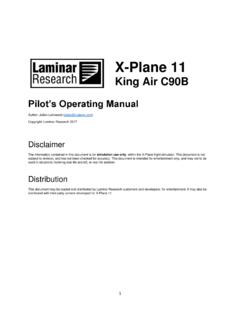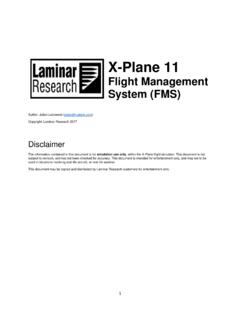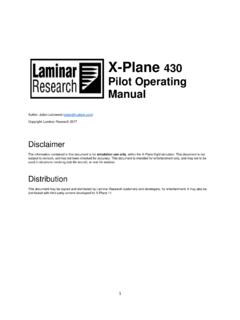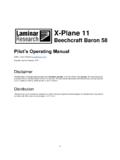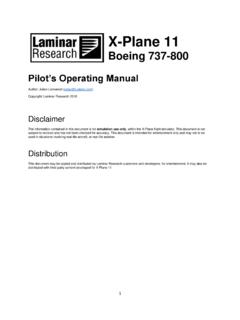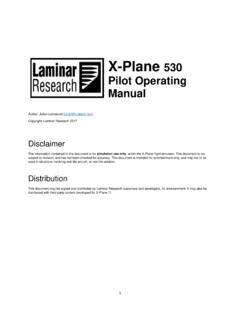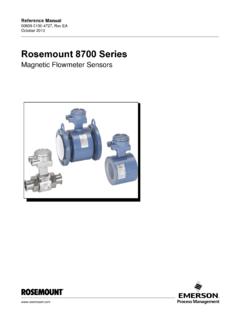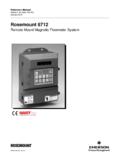Transcription of X-Plane 11
1 X-Plane 11. Boeing 737-800. Pilot's Operating Manual Author: Julian Lockwood Copyright: Laminar Research 2018. Disclaimer The information contained in this document is for simulation use only, within the X-Plane flight simulator. This document is not subject to revision and has not been checked for accuracy. This document is intended for entertainment only and may not to be used in situations involving real-life aircraft, or real-life aviation. Distribution This document may be copied and distributed by Laminar Research customers and developers, for entertainment.
2 It may also be distributed with third-party content developed for X-Plane 11. 1. Contents Background: The Boeing 737 .. 5. B737-800 series Specifications .. 6. The X-Plane B737-800 .. 7. Views and Controls .. 8. Creating Quick Look views .. 9. Operating the controls .. 12. Assigning peripheral devices .. 14. A Tour of the Cockpit .. 17. Forward Overhead Panel .. 17. 1. Flight Controls .. 18. 2. AC and DC Metering .. 18. 3. Transfer .. 19. 4. Standby Power & Generator Bus .. 19. 5. Fuel .. 20. 7. Ice & Rain Protection.
3 21. 8. Temperature Control .. 21. 9. Pneumatics .. 22. 10. Hydraulics .. 22. 12. Miscellaneous .. 23. Aft Overhead Panel .. 24. 1. Emergency Locator Transmitter (ELT) .. 25. 2. Dome Light .. 25. 3. Audio Control .. 26. 4. Electronic Engine Control (EEC) .. 26. Primary Instrument panels .. 28. Electronic Attitude Director Indicator (EADI).. 28. Electronic Horizontal Situation Indicator (EHSI) .. 29. Backup EADI/EHSI .. 29. Instrument Lighting Control Panel .. 30. Chronometer .. 30. Tiller .. 31. Annunciators.
4 31. 2. Electronic Attitude Director Indicator (EADI) Components .. 32. Mach Number .. 32. FMC SPD .. 32. 32. VNAV .. 32. Altitude Pre-Set .. 32. Altitude Scale .. 33. Flight Director Horizontal Deviation Bar .. 33. Current Altitude .. 33. ILS Vertical Deviation Scale .. 33. Static Reference Lines .. 33. Airspeed Scale .. 33. Current Airspeed .. 33. Flight Director Vertical Deviation Bar .. 33. Altitude Above Ground (AGL) .. 33. Heading Bug .. 33. Magnetic Heading .. 33. Altimeter Setting .. 33. Electronic Horizontal Situation Indicator (EHSI) 34.
5 Electronic Horizontal Situation Indicator (EHSI) Control Panel .. 36. Flight Path Vector Display .. 36. MTRS .. 36. Baro Rotary .. 36. VOR 2 .. 36. Map Display Distance .. 36. Features Buttons .. 36. MINS Reference Selector .. 36. VOR 1 .. 36. EHSI Mode .. 37. Center 38. Upper EICAS (Engine Indications and Crew Alerting System) Display .. 39. Lower EICAS (Engine Indications and Crew Alerting System) Display .. 41. FMS Control Display Units (CDUs) .. 42. 3. Center Pedestal .. 43. Thrust Levers .. 43. Speed Brake 44.
6 Flap Lever .. 44. Pitch Trim 45. Fuel Control Levers .. 45. VHF (Comm) Radios .. 46. NAV Radios .. 46. Transponder .. 47. Audio Control .. 47. Lighting .. 48. Trim .. 48. Autopilot Operation .. 49. 52. Flight 55. Fuel Calculation .. 56. Load Sheet Tables .. 56. Setting the Weight, Balance and Fuel in X-Plane .. 62. Checklists .. 63. Pre-Flight Exterior Inspection .. 63. Cold and Dark to Engine Start .. 65. Before Taxi .. 73. Before 76. After Takeoff .. 77. Cruise .. 78. Before Landing .. 79. Landing .. 80. After 81.
7 Parking .. 83. 4. Background: The Boeing 737. The Boeing corporation developed the 737 in the mid-1960s to serve as a lower-cost twin-engined, short- range companion to the larger 727. and 707 models. Production of the original variant (designated 100). began in 1966, with capacity for 85. passengers, five-abreast seating, and powered by two Pratt & Whitney JT8D-15 low-bypass turbofan engines, situated beneath the wings. A slightly larger model 200 followed in 1967, with increased thrust to compensate for additional weight.
8 In 1984, Boeing introduced the first of three variants that would subsequently be designated Classics . These were the 300, 400. and 500 series . The new models were heavily revised, and featured winglets for increased lift and range, and CFM International CFM56-3C-1 high-bypass turbofan engines. Modifications to the landing gear to incorporate the larger engines was required. The Classics' were larger, quieter and more economical, and also featured EFIS CRT avionics, replacing conventional instrumentation. In 1998, Boeing again heavily revised the 737, with the 600, 700, 800 and 900 variants, designated NG' (Next Generation).
9 These aircraft featured FADEC controlled CFM56-7 high-bypass turbofan engines, larger and more efficient wings (without winglets in some cases), a strengthened fuselage, revised avionics, and a higher cruise speed. In 2016 (as a response to the Airbus A320 NEO), Boeing introduced the MAX' series designated MAX-7, MAX-8, MAX-9, MAX- 10, MAX-200. The MAX-8 was the first to enter service in 2017. The MAX variants offer four lengths, with options for 138 to 230. seats and a range of between 3,215 and 3,825 nautical miles.
10 These aircraft are equipped with split winglets and powered by the CFM International LEAP high-bypass turbofan engines. The Boeing 737 (all variants including military and cargo not discussed above) is the highest-selling commercial jetliner in history, with over 10,000 deliveries as of 2018. 5. B737-800 series Specifications Engines: Model ---------------------------------------- - 2 x CFM56-7B24 turbofans Power ---------------------------------------- - 2 x 24,200 lb. thrust Fuel: Capacity ---------------------------------------- - 6,875 Gallons / 26,020 liters / 46,000 lbs.
